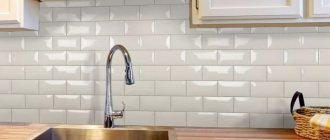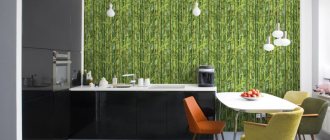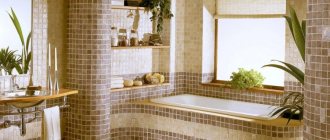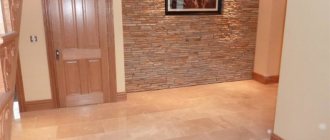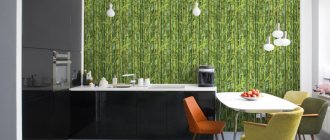During cooking, food residues and drops of fat fall on the walls. To protect walls, you need a material that is easy to clean and will last a long time. One of them is kitchen backsplash tiles. In the article we will talk about the types, their quality and methods of use.
Using tiles for a kitchen backsplash - pros and cons
Kitchen backsplash tiles have been used for a long time and have become traditional. It is very affordable, easy to install and beautiful. Kitchen walls experience enormous stress every day, so they must be reliably protected. Positive sides:
- Good water resistance. It allows the tiles to neither swell nor change color, deform or warp from water, steam and grease.
- Due to the smooth surface of the tiles, the kitchen apron is simply washed off from various contaminants.
- High reliability and long service life up to several decades.
- The surface is not favorable for the growth of bacteria.
- Ceramics are resistant to fire, so they do not deteriorate from high temperatures and can be installed above the stove.
- The material is resistant to chemicals, so it can be cleaned by any means.
- Many colors, decor and the ability to combine with any other interior decoration.
Negative sides:
- Stone varieties need to be treated with special impregnation and careful care.
- The tiles cannot be dismantled and placed in other places, so they are installed for a long time.
- Careful care of seams is necessary because bacteria can grow in them. When installing, you can make them minimal, then there will be no difficulties with cleaning.
- Not all types of masonry can be done independently without experience, for example, herringbone.
Properties of tile panels and their care
An expressive element of wall cladding, due to its close proximity to the hob, sink and countertop, where it is customary to perform culinary tasks, must have excellent performance properties:
Mosaic garden landscape with birds
Magnificent kitchen apron made of small mosaics
In order to maintain the impeccable appearance of a tile painting for a long time, you need to choose models that do not require delicate care. On the glazed and glass surface of the tile, marks from splashes of grease and water are more visible, in contrast to models with a matte finish. Therefore, in the cooking area, the original design element should be protected as much as possible from the negative influence of the surrounding kitchen environment.
Types of tiles
Ceramic
Reliable kitchen tiles are made from clay and sand using pressing. Standard thickness from 3mm. up to 4mm. She is a classic.
Mosaic
Mosaic for a kitchen apron looks impressive. It uses glass, ceramic and other elements. It takes a long time to install, but the result is impressive. You can cover the surface with one tone, different shades of the same range in a chaotic manner, or lay out a beautiful pattern. It’s not always possible to lay out a beautiful composition yourself – you need experience and dexterity, so designers are invited.
Table setting and holiday recipes for February 23: the best original and traditional dishesTable setting for February 14th - the best ideas and ways to decorate to create a romantic atmosphere
- DIY Easter flower arrangements: master class (photo), original ideas
From glass
Glass slabs are very reliable because they are tempered using a special technology. The image is applied inside, and the surface is covered with smooth, frosted or embossed glass. Depending on the style, tiles are single-colored or with a pattern. Photo printing looks beautiful. However, the material is severely scratched and deteriorated by detergents with abrasives.
Fake diamond
Often they make a noble kitchen apron from tiles based on artificial stone. It is suitable for Provence, loft. It can be made from a concrete solution with the addition of natural stone chips or from composite materials (dyes to look like natural stone). Such materials imitate granite, marble, sand coatings. However, it is not UV resistant and deteriorates due to sudden changes in temperature. You can protect the coating with special colorless varnish and impregnations.
Mirror
An interesting type of glass tile is mirror. It is shock resistant but requires careful maintenance. Painted in a silver color that reflects objects or lighting. Suitable for styles: high-tech, modern, loft.
Imitation of other materials
Imitating tiles for the kitchen work area allow designers to realize any idea, ensuring the durability of the canvas and protection of the walls. The most interesting imitations are: leather, wood, stone. The design is obtained from photo printing; texture can also be added to the slabs so that only a professional can distinguish the materials.
Interesting! More often they imitate other materials only with a pattern, so as not to complicate surface care.
How to decorate the Easter table - ideas, tips for decorating the Easter table, photosHow to decorate a table for March 8: photo of table setting, decoration of dishes
Curtains for the kitchen with a balcony door: how to choose the ideal option
Making egg crackle
It is necessary to cut out the base from the wood board and place it face up. Apply the primer solution to it with a sponge.
Next, you need to gradually lay out the crushed shell (or crush the shell already on the surface of the product) onto a sheet greased with glue. After this, it is immediately re-coated with a layer of PVA glue. The base with crushed shells (mosaic) is allowed to dry for 6-9 hours.
To create decoupage, you can use a colorful napkin (not paper) or a printed photograph. You can also use rice paper (purchased in special stores).
Candle atmosphere: main types of candles for the home- Where can I find a gift?
- Schemes for the location of spotlights in the kitchen
Next, you need to glue the image without creating folds on it, placing a transparent file on it.
The applied fragment is leveled and gently smoothed with your fingers. Then the file is slowly removed and decoupage glue is applied to the product. After final drying, acrylic paints are applied to some parts of the panel and a varnish coating is applied.
For the base when creating extraordinary, exquisite panels you can use: nuts, dried fruits and vegetables, cereals, patterned pasta, spoons, knives, forks, bottle caps and much more.
Here the choice directly depends only on the style of the kitchen interior, wishes and fantasies.
Masonry options
There are many ways to lay tiles, we will list the popular ones.
Standard
According to the standard, tiles in the kitchen are laid seam to seam. This arrangement allows you to save materials, because there is a complete coincidence of the rows. It is better to calculate the amount of material before purchasing so that trimming will be required.
Herringbone
The herringbone arrangement of the apron is beautiful and suitable for country, Provence, and loft styles. But it’s difficult to do it yourself without experience.
Diagonally
Diagonal laying is used to create patterns. The result is a beautiful look, but a lot of pruning will be required, so the consumption will increase.
Popular colors
Pastel shades
The traditional apron in the kitchen, suitable for all types of interiors, is white. It visually distances objects, so it can be used even in small rooms. He is always stylish and will not get boring.
Beige tones are best used for classic or Provence. But it can also be introduced into modern interiors if the undertones are taken into account correctly. Beige is very soft and can be easily combined with other colors.
The lavender tone is beautiful and suitable for Provence. And for minimalism and hi-tech, gray tiles will be expressive. They can be laid in random order of different undertones to get an unusual design.
Deep shades
Deep purple color is suitable for modern style. For example, bright pop art. However, it can only be used in spacious rooms so as not to reduce the ambience.
A rich green tone will add freshness and tranquility to the room. A boar tile can create a beautiful decor.
Bright colors
A striking combination would be a black and white combination. It is not necessary to dilute it with other shades, because two basic tones create an original setting. A black mosaic with white seams will look beautiful on an apron.
An unusual apron for the kitchen can be made in red. It draws attention to itself, so the rest of the environment should be neutral. You can combine it with a snow-white set. This combination would be perfect for a loft style if the hog tiles imitate brickwork. For modern stylists, a red mosaic will look interesting. You can complement the interior with scarlet textiles.
By adding a bright green tone, you get an environment filled with life and energy. You can combine it with natural shades: brown, beige, white.
Decorative inserts
There are interesting finishing options that will allow you to diversify the background shades:
1 Use of decorative panels. This technique is often used in country, Provence and classical styles. One large 60cm tile can be inserted in the center of the composition. at 60cm, 50cm. by 30cm, 80cm. at 60cm., 60cm. by 40cm. It is not uncommon that instead of one large one, 4 pieces are used. or 6 pcs. average.
To make the panel look appropriate, you will need symmetry and enough space. Most often it is placed above the stove, but if you have a long set, you can place several panels at the same distance. From the drawings you can choose any one that suits your style. For example, images of flowers are suitable for Provence, and carved patterns are suitable for classical days. You can create an interesting composition with images of cities, villages, and beautiful nature.
2 “Pencil” decor. It is a strip that runs through the middle of a surface of any width. This trick not only decorates the decor, but also simplifies installation. Often the size of the middle strip is selected to prevent cutting of the slabs.
3 “Border”, frieze. This decor is similar to pencil decor, but a strip of varying sizes is mounted above the lower cabinets or under the upper ones. It also allows you to avoid cutting the tiles if you calculate everything correctly.
4 Tiles with a pattern or relief. They do not differ in size from the background ones, but have an interesting flat or convex pattern. They are distributed over all surfaces at the same or different distances. Sometimes they are used to create a decorative panel.
Selecting tiles to match the style of the kitchen
Choosing a design for a tile backsplash is not difficult if you know the style of the room. For a classic interior, tiles made of natural or artificial stone are suitable. You can add a decorative panel.
The loft style will be complemented by tile trim on the apron along the brickwork. To do this, choose red shades. Recently, tiles have often begun to be decorated to look like aged brick.
For minimalism and hi-tech, monochromatic models made of mosaics and hogs are suitable. The main thing is to maintain a black-white-gray color scheme.
Design
The panel itself attracts attention, so an excessive number of flashy details in the neighborhood will only spoil the overall impression. And when choosing a general concept, you should definitely take this fact into account in the following examples:
- Pastel. Laconic facades without handles, glossy surfaces made of stone countertops, wooden cabinets against the backdrop of a creamy beige interior.
- Saturation. At first glance, completely incompatible shades: like a blue accent in a black and white kitchen. Here they recommend not only monochrome, but also warmer colors.
- Brightness. The fruit insert harmonizes favorably with the bright stripes of the tiles. Most manufacturers have such collections: the decor is dispersed either along the entire length, or concentrated in one part.
Important! The patchwork pattern in a duet with panels should be used carefully: a pattern that is too colorful can cause a negative effect if the cladding occupies a large area of the kitchen
Tips for choosing tiles
When selecting tiles, it is necessary to take into account factors that will allow the surface to serve for a long time:
- Choose a material without relief. Embossed products are more beautiful, but they are much more difficult to clean compared to smooth ones.
- To visually enlarge the room, take a glossy finish. It is also easy to clean, but water streaks and stains are visible in the sun. Therefore, you will need to wipe the surface dry immediately after washing.
- Buy products from the same batch so as not to miss the mark with color and texture. If you have to purchase from different batches, make sure they are completely identical.
- Check for the presence of a protective layer. It prevents chemicals from penetrating deep into the material and destroying it. The best indicators of the degree of protection are “A” and “AA”.
- The quality of the coating is also important - there should be no cracks, abrasions or chips.
- Before purchasing, it is worth looking at the error of actual values. If the indicator is “0”, then there is no size error. If "1", then this is acceptable. Higher values will not allow you to lay the tiles evenly, because everything will be crooked due to different sizes.
Interesting! To prevent the material from cracking after installation, it must be stored correctly. Before installation, the slabs should be kept in a room with low humidity.
To ensure that you don’t get tired of tiled kitchen backsplashes for a long time, you also need to take into account the designers’ recommendations.
| 1 | To focus attention on the protective surface, use bright colors, mosaics, panels, photo printing, etc. |
| 2 | If the accents in the room are made by other things, then choose a neutral color and texture |
| 3 | Bright tiles attract a lot of attention, so it is recommended to install them in large rooms, and use muted colors in small ones. |
| 4 | To make the room harmonious, you need to support the colors of the apron with other elements. For example, a tabletop |
| 5 | The size of the tiles affects the perception of space - small ones increase the size of the room, and large ones reduce it |
Decoration features
Kitchen decor has some features that are different from interior elements in other living spaces. Whatever the panel is made from, if it is planned to be placed close to the cooking area or wet area, it must be durable, resistant to moisture, heat, oil splashes and other external factors, easy to wash and clean from dirt.
Kitchen panels can have any shape and size, the material used can also be different.
As for the theme, size and execution of the future kitchen decoration, in this regard it is worth starting from the dimensions of the room, the general style of the interior, color, material and type of other design elements and furnishings.
A small panel will decorate a wall in the dining area of a small kitchen, several small paintings will form a triptych in a large free space, and large-sized decor will be appropriate in a spacious room. The apron area should be decorated with practical materials throughout the entire area; splashes of water and other household contaminants can get there.
The basic rule for placing panels so that the details are combined with the kitchen design concept
Often the theme for kitchen panels is delicious dishes, dishes, aromatic drinks, or some individual products depicted as a pattern or still life. Cups of coffee, vegetables, fruits, compositions of cereals, seeds, old dishes decorated in a special way are the most popular subjects and wall decor items.
Ceramic panels add unique features to the interior composition
Artificial plastic or papier-mâché fruits mounted on a base of plywood, matting, stretched over cardboard or a special frame produce stunningly realistic, three-dimensional paintings, and this is just one of dozens of possible options.
A panel made by yourself is the very “highlight” that can reflect the character and preferences of the owner of the kitchen
Photo
For inspiration, look at photo examples of popular masonry in real interiors:
How do you like the article?

